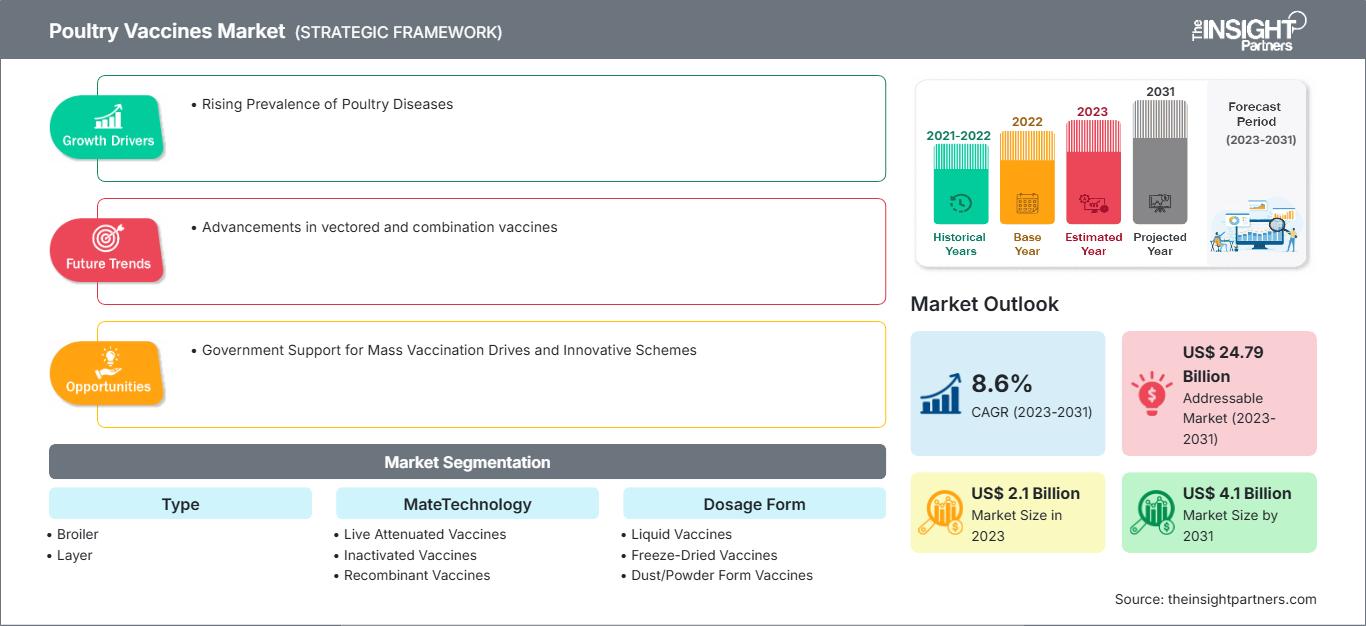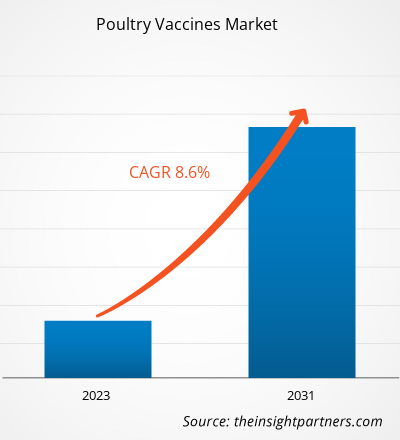Der Markt für Geflügelimpfstoffe soll von 2,1 Milliarden US-Dollar im Jahr 2023 auf 4,1 Milliarden US-Dollar im Jahr 2031 anwachsen. Für den Zeitraum 2023–2031 wird ein durchschnittliches jährliches Wachstum von 8,6 % erwartet. Die Fortschritte bei Vektor- und Kombinationsimpfstoffen bleiben voraussichtlich wichtige Markttrends für Geflügelimpfstoffe.
Marktanalyse für Geflügelimpfstoffe
Steigende Prävalenz von Geflügelkrankheiten
Die Geflügelproduktion führt zur Produktion verschiedener Arten tierischer Proteine in Form von Eiern und Fleisch. Mit der steigenden Geflügelproduktion steigt die Wahrscheinlichkeit einer Anfälligkeit für verschiedene Zoonosen wie die „Geflügelseuche“, die insbesondere in Entwicklungsländern zu enormen wirtschaftlichen Verlusten führen kann. Hühner sind beispielsweise anfälliger für bakterielle, virale, parasitäre und Pilzinfektionen. Diese Virusausbrüche können bei einer Vielzahl von Geflügelarten Newcastle-Krankheit, Vogelgrippe, infektiöse Bursitis und andere Krankheiten verursachen.
Die folgende Tabelle zeigt Krankheitsausbrüche der Vogelgrippe bei Säugetieren in mehreren Ländern im Jahr 2022.
Fälle von Vogelgrippe bei Säugetieren |
||
Land |
Geflügelkrankheiten |
Krankheitsausbruch (2022) |
|
Argentinien |
H5 |
18 |
|
Chile |
34 |
|
|
Norwegen |
2 |
|
|
Uruguay |
3 |
|
|
Peru |
< p>12 | |
|
Brasilien |
H5N1 |
5 |
|
Kanada |
40 |
|
|
China |
1 |
|
|
Estland |
1 |
|
|
Finnland |
76 |
|
|
Frankreich |
2 |
|
|
Irland |
2 |
|
|
Italien |
3 |
|
|
Japan |
4 |
|
|
Russland < /td> |
1 |
|
|
Kanada |
H5N5 |
2 |
|
Dänemark |
H5N8 |
1 |
Quelle: Weltorganisation für Tiergesundheit 2023
Geflügelkrankheiten sind eine der Hauptursachen für den Tod von Küken und führen auch zu einem Rückgang des Viehbestands. Landwirte erleiden weltweit enorme wirtschaftliche Verluste durch die Verbreitung von Zoonosen, die ein ernstes Gesundheitsrisiko für Säugetiere darstellen. Die Geflügelkokzidiose beispielsweise ist eine der weltweit am weitesten verbreiteten Krankheiten. Sie führt zu enormen Verlusten durch Sterblichkeit, Gewichtsverlust und zusätzlichen Kosten für Prävention und Therapie. Laut der Website von DSM entstehen Landwirten durch Kokzidiose bei Hühnern und anderen Vogelarten weltweit jährlich wirtschaftliche Verluste von drei Milliarden US-Dollar. Auch die Newcastle-Krankheit gilt als kostspielige Krankheit, die bei Landwirten in Entwicklungsländern, die Geflügelprodukte exportieren, zu enormen Produktionsverlusten führt. Aus dem im Oktober 2021 veröffentlichten Bericht des International Journal of Current Microbiology and Applied Sciences (IJCMAS) geht hervor, dass die Gesamtverluste aufgrund der Sterblichkeit durch die Newcastle-Krankheit und die Gesamtausgaben für lebende Vögel in allen 25 kommerziellen Masthähnchenfarmen zwischen 17.864 INR (214,0 US-Dollar) und 266.080 INR (3.188,89 US-Dollar) bzw. zwischen 278.393 INR (3.336,46 US-Dollar) und 17.86.745 INR (21.413,6 US-Dollar) lagen. Auch die Verkaufserlöse für lebende Vögel von einzelnen Farmen lagen aufgrund von Infektionen zwischen 160.255 INR (1.920,61 USD) und 12.46.314 INR (14.936,7 USD).
Die zunehmende Verbreitung von Geflügelkrankheiten, die zu enormen wirtschaftlichen Verlusten führt, steigert daher die Nachfrage nach Geflügelimpfungen und treibt den Markt an.
Marktübersicht für Geflügelimpfstoffe
Indien hat den zweitgrößten Marktanteil im asiatisch-pazifischen Raum. Indien nimmt auf dem globalen Markt für Geflügelimpfstoffe eine bedeutende Position ein. Die wirtschaftliche Bedeutung der Geflügelindustrie lässt sich anhand der Tatsache abschätzen, dass die indische Geflügelindustrie ca. 0,7 % des nationalen BIP und 10 % des BIP der Viehzucht ausmacht. In der jüngeren Vergangenheit war die indische Geflügelwirtschaft häufig mit neuen Geflügelkrankheiten wie der Vogelgrippe (Aviäre Influenza, AI) konfrontiert, was zu enormen Verlusten in der indischen und weltweiten Geflügelwirtschaft führte. Die Vogelgrippe hat sich zu einer unvorhersehbaren Bedrohung für die indische Geflügelwirtschaft entwickelt und in den letzten zehn Jahren mehr als 176 Ausbrüche verursacht, die der Geflügelwirtschaft erhebliche wirtschaftliche Verluste bescherten. Jeder gemeldete AI-Ausbruch führt zu Verzerrungen der Inlandsnachfrage und in der Folge zu Preisverzerrungen und Verzerrungen im Welthandel. Wissenschaftliche Interventionen sind dringend erforderlich, um die Bedrohung durch solche neu auftretenden Geflügelkrankheiten im Land einzudämmen. Derzeit wird die Impfung gegen die Vogelgrippe jedoch nicht in die Routineimpfprogramme integriert. Daher bedarf es eines prädiktiven analytischen Ansatzes zur Vorhersage von Ausbrüchen und, was noch wichtiger ist, eines sicheren und wirksamen Impfstoffs gegen die Vogelgrippe.
Passen Sie diesen Bericht Ihren Anforderungen an
Sie erhalten kostenlos Anpassungen an jedem Bericht, einschließlich Teilen dieses Berichts oder einer Analyse auf Länderebene, eines Excel-Datenpakets sowie tolle Angebote und Rabatte für Start-ups und Universitäten.
Markt für Geflügelimpfstoffe: Strategische Einblicke

-
Holen Sie sich die wichtigsten Markttrends aus diesem Bericht.Dieses KOSTENLOSE Beispiel umfasst Datenanalysen, die von Markttrends bis hin zu Schätzungen und Prognosen reichen.
Markttreiber und -chancen für Geflügelimpfstoffe
Fortschritte bei Vektor- und Kombinationsimpfstoffen
Vektorimpfstoffe funktionieren anders als herkömmliche Impfstoffe und bieten mehrere Vorteile. Zu diesen Vorteilen gehören unter anderem das Ausbleiben von Nebenwirkungen, die Überwindung mütterlicher Antikörperinterferenzen und die Bewältigung neu auftretender Krankheitsherausforderungen. „Vaxxitek HVT+IBD+ND“ ist ein Beispiel für einen Vektorimpfstoff von Boehringer Ingelheim und wurde 2019 auf dem US-Markt eingeführt. Es handelt sich um einen trivalenten Impfstoff, der gegen drei Krankheiten wirksam ist: Marek-Krankheit (MD), Infektiöse Bursitis (IBD) und Newcastle-Krankheit (ND). Darüber hinaus erhielt 2020 eine zweite trivalente Form, „Vaxxitek HVT+IBD+ILT“, in den USA die Marktzulassung zum Schutz vor MD, IBD und Infektiöser Laryngotracheitis (ILT). Dies sind allesamt hochansteckende und kommerziell störende Krankheiten, die die Geflügelindustrie weltweit betreffen, und Vaxxitek erweist sich als hilfreich bei der Überwindung solcher Krankheiten mit einer Impfung. Dass neben Boehringer Ingelheim auch andere Hersteller solche bivalenten und trivalenten Impfstoffe produzieren, wird die globale Nachfrage steigern. Große Hersteller planen zudem die Beschaffung von pentavalenten Impfstoffen, die sich bei der Überwindung von Geflügelkrankheiten als hilfreich erweisen und ihnen helfen werden, sich auf dem Weltmarkt abzuheben. Somit stellen die Fortschritte bei der Produktion von Vektor- und Kombinationsimpfstoffen einen neuen Trend dar, der das Marktwachstum für Geflügelimpfstoffe in den kommenden Jahren wahrscheinlich ankurbeln wird.
Staatliche Unterstützung für Massenimpfkampagnen und innovative Programme
Angesichts der steigenden globalen Krankheitslast (GBD) unterstützen Regierungen weltweit die Impfung von Geflügel. Die Unterstützung umfasst die Einführung von Massenimpfprogrammen und mehreren Impfprogrammen in Impfzentren oder über Hausimpfdienste.
- Im Dezember 2022 kündigte die indische Regierung die Einführung von Programmen wie dem „Livestock Health & Disease Control Scheme“ an, das den Tiergesundheitssektor durch die Umsetzung prophylaktischer Impfprogramme gegen verschiedene Krankheiten verbessern soll. Dieses Programm wird zentral oder staatlich gesteuert und im Verhältnis 60:40 finanziert. Außerdem umfasst das Programm „Forschung & Innovation, Öffentlichkeitsarbeit & Bewusstseinsbildung, Schulung & damit verbundene Aktivitäten“, die zu 100 % zentral finanziert werden.
- Im April 2023 kündigte die französische Regierung die Vergabe einer Ausschreibung für die Bestellung von 80 Millionen Dosen Vogelgrippe-Impfstoff an, da das Land ein Massenimpfprogramm vorbereitete. Das französische Ministerium „ANES“ war das erste Land in der Europäischen Union (EU), das ein derartiges Massenimpfprogramm startete. Zur Durchführung einer solchen Massenimpfkampagne beauftragte Frankreich zwei Unternehmen, das französische Unternehmen Ceva Animal Health und das deutsche Unternehmen Boehringer Ingelheim, mit der Entwicklung von Impfstoffen gegen die Vogelgrippe. Beide Impfstoffe der beiden Unternehmen schützen Vögel wirksam vor dem Virus.
Daher wird erwartet, dass diese staatliche Unterstützung für Massenimpfkampagnen und die Entwicklung innovativer Programme in den kommenden Jahren lukrative Möglichkeiten für das Wachstum des Geflügelmarktes bietet.
Segmentierungsanalyse des Marktberichts für Geflügelimpfstoffe
Schlüsselsegmente, die zur Ableitung der Marktanalyse für Geflügelimpfstoffe beigetragen haben, sind Typ, Technologie, Darreichungsform, Krankheit, Verabreichungsweg und Endverbraucher.
- Basierend auf dem Typ ist der Markt für Geflügelimpfstoffe in Masthähnchen- und Legehennenimpfstoffe unterteilt. Das Broilersegment hatte 2023 einen größeren Marktanteil.
- Nach Technologie ist der Markt in Lebendimpfstoffe, inaktivierte Impfstoffe und rekombinante Impfstoffe unterteilt. Das Segment der Lebendimpfstoffe hatte 2023 den größten Marktanteil.
- In Bezug auf die Darreichungsform ist der Markt in Flüssigimpfstoffe, gefriergetrocknete Impfstoffe und Impfstoffe in Staub-/Pulverform unterteilt. Das Segment der Flüssigimpfstoffe dominierte den Markt im Jahr 2023.
- In Bezug auf die Krankheiten ist der Markt in Vogelgrippe, Vogelsalmonellose, Marek-Krankheit, infektiöse Bronchitis, infektiöse Bursitis (IBD), Newcastle-Krankheit und andere unterteilt. Das Segment Vogelgrippe dominierte den Markt im Jahr 2023.
- In Bezug auf die Verabreichungsart ist der Markt in Trinkwasser (D/W), intramuskuläre (I/M), subkutane (I/S) und andere unterteilt. Das Segment Trinkwasser (D/W) dominierte den Markt im Jahr 2023.
- In Bezug auf den Endverbraucher ist der Markt in Geflügelfarmen, Tierkliniken und Geflügelimpfzentren und -kliniken segmentiert. Das Segment Geflügelfarmen dominierte den Markt im Jahr 2023.
Marktanteilsanalyse für Geflügelimpfstoffe nach Geografie
Der geografische Umfang des Marktberichts für Geflügelimpfstoffe ist hauptsächlich in fünf Regionen segmentiert: Nordamerika, Asien-Pazifik, Europa, Naher Osten und Afrika sowie Süd- und Mittelamerika.
Der asiatisch-pazifische Raum dominiert den Markt für Geflügelimpfstoffe und wird in den kommenden Jahren voraussichtlich die höchste durchschnittliche jährliche Wachstumsrate (CAGR) aufweisen. Im asiatisch-pazifischen Raum hatte China im Jahr 2022 den größten Anteil am Markt für Geflügelimpfstoffe. China erlebt ein rasantes Wirtschaftswachstum und eine rasante Urbanisierung. China verfügt über eines der bedeutendsten Gesundheitssysteme der Region. Das Marktwachstum des Landes ist auf die steigende Nachfrage nach Geflügelfleisch, den zunehmenden Konsum von Lebensmitteln tierischen Ursprungs, den wachsenden Viehbestand, das zunehmende Bewusstsein für Tiergesundheit und die zunehmende Häufigkeit von Geflügelkrankheiten in China zurückzuführen. Daher sind positive Regierungsinitiativen zur Förderung der Impfung der chinesischen Bevölkerung der Schlüsselfaktor für das Wachstum des Marktes für Geflügelimpfstoffe.
Geflügelimpfstoffe
Regionale Einblicke in den Markt für Geflügelimpfstoffe
Die Analysten von The Insight Partners haben die regionalen Trends und Faktoren, die den Markt für Geflügelimpfstoffe im Prognosezeitraum beeinflussen, ausführlich erläutert. In diesem Abschnitt werden auch die Marktsegmente und die geografische Lage in Nordamerika, Europa, dem asiatisch-pazifischen Raum, dem Nahen Osten und Afrika sowie Süd- und Mittelamerika erörtert.
Umfang des Marktberichts über Geflügelimpfstoffe
| Berichtsattribut | Einzelheiten |
|---|---|
| Marktgröße in 2023 | US$ 2.1 Billion |
| Marktgröße nach 2031 | US$ 4.1 Billion |
| Globale CAGR (2023 - 2031) | 8.6% |
| Historische Daten | 2021-2022 |
| Prognosezeitraum | 2023-2031 |
| Abgedeckte Segmente |
By Typ
|
| Abgedeckte Regionen und Länder |
Nordamerika
|
| Marktführer und wichtige Unternehmensprofile |
|
Dichte der Marktteilnehmer für Geflügelimpfstoffe: Auswirkungen auf die Geschäftsdynamik verstehen
Der Markt für Geflügelimpfstoffe wächst rasant. Die steigende Nachfrage der Endverbraucher ist auf Faktoren wie veränderte Verbraucherpräferenzen, technologische Fortschritte und ein stärkeres Bewusstsein für die Produktvorteile zurückzuführen. Mit der steigenden Nachfrage erweitern Unternehmen ihr Angebot, entwickeln Innovationen, um den Bedürfnissen der Verbraucher gerecht zu werden, und nutzen neue Trends, was das Marktwachstum weiter ankurbelt.

- Holen Sie sich die Markt für Geflügelimpfstoffe Übersicht der wichtigsten Akteure
Marktnachrichten und aktuelle Entwicklungen zu Geflügelimpfstoffen
Der Markt für Geflügelimpfstoffe wird durch die Erhebung qualitativer und quantitativer Daten aus Primär- und Sekundärforschung bewertet, die wichtige Unternehmenspublikationen, Verbandsdaten und Datenbanken umfasst. Im Folgenden finden Sie eine Liste der Entwicklungen auf dem Markt für Geflügelimpfstoffe und -strategien:
- Im April 2021 kündigte Boehringer Ingelheim, ein weltweit führendes Unternehmen im Bereich Tiergesundheit, die Markteinführung von Prevexxion RN und Prevexxion RN+HVT+IBD, der nächsten Generation von Impfstoffen gegen die Marek-Krankheit, in den Ländern der Europäischen Union und Großbritannien an. (Quelle: Boehringer Ingelheim, Pressemitteilung, 2021)
Bericht zum Markt für Geflügelimpfstoffe: Abdeckung und Ergebnisse
Der „Markt für Geflügelimpfstoffe – Größe und Prognose (2021–2031)“ Der Bericht bietet eine detaillierte Analyse des Marktes und deckt die folgenden Bereiche ab:
- Marktgröße und -prognose auf globaler, regionaler und Länderebene für alle abgedeckten wichtigen Marktsegmente
- Marktdynamik wie Treiber, Beschränkungen und wichtige Chancen
- Wichtige zukünftige Trends
- Detaillierte PEST- und SWOT-Analyse
- Globale und regionale Marktanalyse mit wichtigen Markttrends, wichtigen Akteuren, Vorschriften und aktuellen Marktentwicklungen
- Branchenlandschaft und Wettbewerbsanalyse mit Marktkonzentration, Heatmap-Analyse, prominenten Akteuren und aktuellen Entwicklungen
- Detaillierte Unternehmensprofile
- Historische Analyse (2 Jahre), Basisjahr, Prognose (7 Jahre) mit CAGR
- PEST- und SWOT-Analyse
- Marktgröße Wert/Volumen – Global, Regional, Land
- Branchen- und Wettbewerbslandschaft
- Excel-Datensatz
Aktuelle Berichte
Erfahrungsberichte
Grund zum Kauf
- Fundierte Entscheidungsfindung
- Marktdynamik verstehen
- Wettbewerbsanalyse
- Kundeneinblicke
- Marktprognosen
- Risikominimierung
- Strategische Planung
- Investitionsbegründung
- Identifizierung neuer Märkte
- Verbesserung von Marketingstrategien
- Steigerung der Betriebseffizienz
- Anpassung an regulatorische Trends






















 Kostenlose Probe anfordern für - Markt für Geflügelimpfstoffe
Kostenlose Probe anfordern für - Markt für Geflügelimpfstoffe